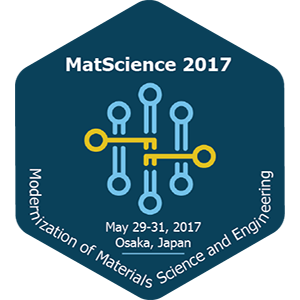
Ganesh Agawane
Korea Photonics Technology Institute, South Korea
Title: Enhanced 1.53 μm emission from Er/Yb fluorophosphate glasses for optical amplifiers
Biography
Biography: Ganesh Agawane
Abstract
Statement of the Problem: Erbium doped fiber amplifiers (EDFAs) have been studied extensively to convert the NIR radiation into the visible light. The EDFAs can be applied in numerous optical applications like; optical fiber communication, data storage, biomedical diagnostic, color display, sensor, eye-safe laser and undersea optical communication. The host glass matrix noticeably affects the emission properties of the rare earth ions and, therefore, a broad study is obligatory for the exploration of the paramount apt host matrix. Fluorophosphate (FP) provides an excellent way to obtain the best matrix for doping of rare earths. The FP matrixes endure fracture toughness effortlessly making stable solid state lasers over extensive physical qualities. These matrixes are perfect for large inhomogeneous augmentation, superior broadband and flatness due to low phonon energy. Methodology & Theoretical Orientation: In this study, we report preparation of Er3+/Yb3+ co-doped fluorophosphate (FP) glasses containing aluminium-metaphosphate by melt quenching technique. The UV-Vis-NIR absorption measurements were carried out and analyzed through Judd–Ofelt model. Various spectroscopic properties like radiative lifetime, transition probability, intensity parameters Ωλ, emission cross-sections and stimulated absorption cross-sections at 1.53 μm have been evaluated. Findings: In this study, we report preparation of Er3+/Yb3+ co-doped fluorophosphate (FP) glasses containing aluminium-metaphosphate by melt quenching technique. The UV-Vis-NIR absorption measurements were carried out and analyzed through Judd–Ofelt model. Various spectroscopic properties like radiative lifetime, transition probability, intensity parameters Ωλ, emission cross-sections and stimulated absorption cross-sections at 1.53 μm have been evaluated. The fluorescence lifetime was measured and calculated by non-exponential least square fit technique. The lifetime of the glasses first increased and then decreased with increased Yb3+ mol%. Conclusion & Significance: Near infrared absorption and absorption cross-section were increased with an increase in YbF3 content. Emission elucidations showed that the glass matrix and concentration of Er3+ and Yb3+ ions significantly impact the emission characteristics and radiative lifetimes. The longest lifetime of 12 ms proved the better host matrix and 2 mol% YbF3 is the best condition for Er co-doped glasses.

